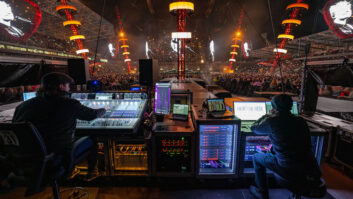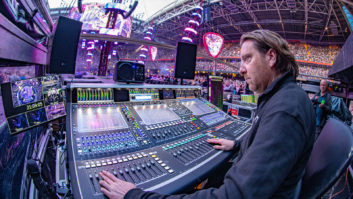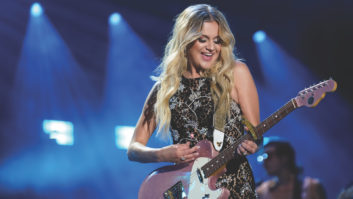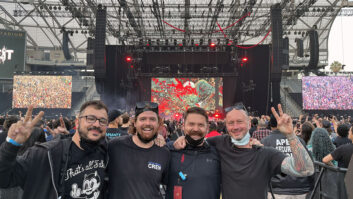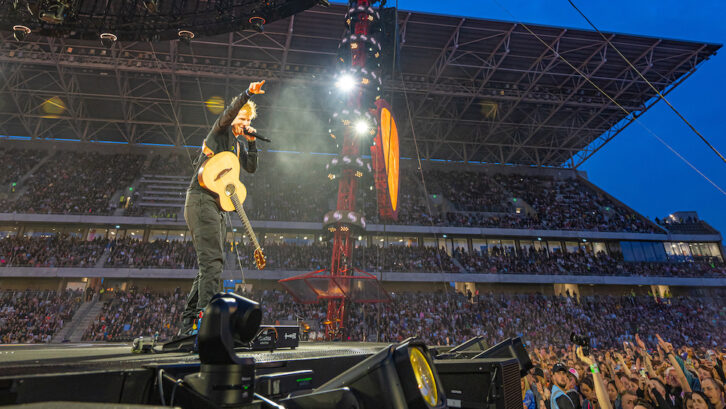
When your last world tour ran 260 shows across two years and took the world record for highest-grossing concert tour of all-time, what do you do for an encore? That was the conundrum facing Ed Sheeran in the wake of his 2017-19 Divide tour, which played for 8.9 million people around the globe and brought home a staggering $776.2 million in the process. The troubadour’s answer was to hit the road with his current Mathematics tour, a production that despite its name is anything but “by the numbers.”
Launched in April 2022 and currently crossing North America on a 28-date stadium leg, the world tour uses its in-the-round setting and cutting-edge audio equipment to create an intimate experience, despite drawing some truly massive crowds. Case in point: Sheeran’s two shows this past March at Australia’s Melbourne Cricket Ground played for a total of 211,000 people.
While not spartan, the show’s unique, clean staging prioritizes unobstructed sight lines, even as it incorporates plenty of video screens, loads of lighting, pyro, fireworks and, not to be overlooked, a brand-new P.A. that made its worldwide debut in front of 70,000 people on the tour’s opening night at Dublin’s Croke Park.
The show’s focal point is a center stage beneath a circular, 360-degree video screen suspended by a network of cables. Those, in turn, stem from six masts out in the crowd that also support a half-dozen giant guitar pick-shaped video screens and 14 P.A. hangs. Adding to their functionality, four of the masts each have a stage at the base for a member of Sheeran’s backing band, while the other two masts stand above the two FOH positions, including the one where production director, project manager and tour engineer Chris Marsh spends his evenings bringing mixes to the masses.
HANDS FULL AT FRONT OF HOUSE
There are stadium acts that wouldn’t dream of taking the stage without the aid of playback, timecode and a click in their in-ears; the Sheeran tour has none of that. While the choice removes some of the modern-day safety nets that technology can provide, it also ensures that audiences get a truly live show, regardless of whether Sheeran is performing solo and using loopers to build his songs live, or playing with his backing band. Either way, it all makes for a complex concert that Marsh mixes nightly on a DiGiCo Quantum 7 console setup—and as the engineer pointed out, “No show is the same, as there are so many variables.”
Despite the new presence of additional musicians, the performances don’t always hew closely to the familiar recorded versions, treating fans to new interpretations from both the musicians’ and the mixer’s point-of-view. “I have no intention of attempting to reproduce the album versions of the songs Ed performs,” said Marsh, “primarily as they are arranged and performed in a completely different way to which the songs were recorded.”
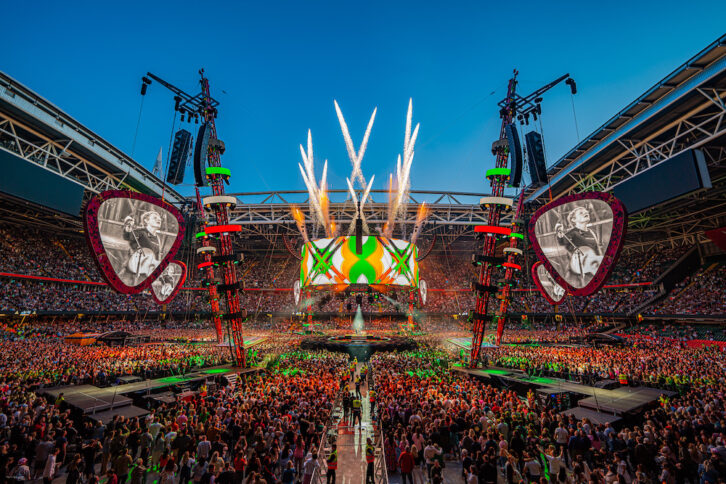
Keeping things flexible lends freshness to every show, but it also presents its own set of challenges, as Marsh noted: “I must be very disciplined on watching for cues and following set procedures whilst also being able to respond to environmental factors to keep the mix together.”
In an age where many tours carry endless plug-ins that emulate key outboard units, the Mathematics tour pointedly uses the real thing; there are no plug-ins to be found at front-of-house. Instead, the show’s sound is very much altered by physical knobs getting turned on physical rack units. For reverbs, there’s a pair of Bricasti M7 stereo reverb processors, with one on Sheeran’s vocal and the other on his guitar. Given the enormous stadiums on the itinerary, it’s easy to imagine the details of a reverb would get lost, but Adam Wells, audio system engineer for the production, affirmed, “We’ve had some gigs where of course we’re in a massive room and you question if you can hear them—and then you get these incredible gigs where they really come to life and you can hear exactly what they’re doing.”
Other outboard gear on-hand includes a Cedar DNS8, used as a primary source enhancer to clean up vocals and drum mics, and a Waves MaxxBCL. Adding some weight to the bottom end, the MaxxBCL is inserted over the left-right bus and gets the subs going when Sheeran thumps the body of his acoustic guitar for a kick drum-like sound.
Despite the new addition of backing musicians, the parts of the show where Sheeran builds songs with loops remain among the most interesting to tackle, said Marsh: “There are several songs that are performed on the looper that are challenging to mix. It is really important to try and balance the live playing with what becomes the recorded loop—this can be difficult to gauge at times, but is very satisfying when you achieve it!”
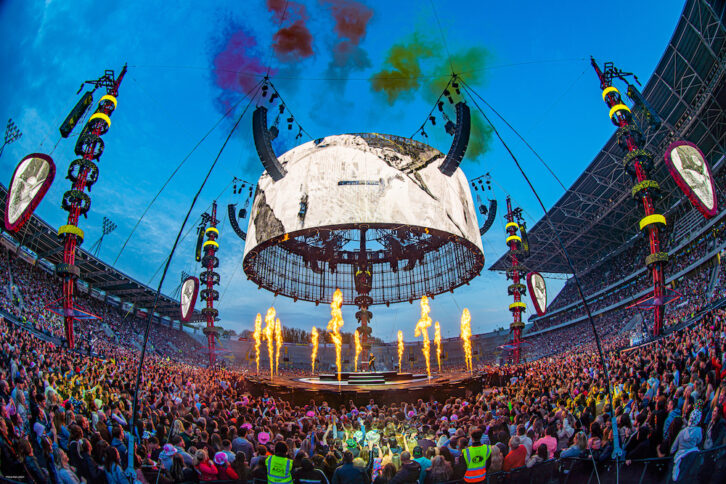
MODERN MONITORING
In keeping with the design aesthetic, the stages are kept clean; other than a pedal board and keyboard, Sheeran’s center stage is devoid of visual distractions like floor monitors. The same goes for the backing musicians at their remote stages, so all the performers wear JH Audio Roxanne in-ear monitors to keep locked in with each other, despite the near 50-meter distances between them.
The engineer behind those monitor mixes…is Marsh. “Monitoring is surprisingly easy on this tour,” he said, explaining, “We have been looking after Ed’s monitoring from FOH for years, but with the addition of a band, we did consider adding a monitor engineer and console. However, the unique layout of the staging meant that there was no ideal place to have a monitor console. The best solution was to allow the musicians to mix themselves, so we integrated Klang and Klang:kontroller into our system, and we were off.”
Klang immersive in-ear mixing is integrated into Marsh’s DiGiCo Quantum7 via a DMI-Klang card, providing real-time spatial audio mixes into each musician’s IEMs. The tour later dropped the kontrollers—hardware controllers that can be used as personal monitor mixers—and Marsh now handles mix requests during soundcheck, though he readily admitted, “I would not suggest this as ‘the way forward,’ but rather a unique solution to a very unique set of requirements.”
All RF vocal mics on the tour are Sennheiser 6000 Digitals. The drum kit is captured primarily via DPA 4099 CORE mics, along with a Sennheiser e901 on the kick and e904s on the toms, plus a Shure Beta 56A for the snare. All that is supplemented by triggers on the drums, allowing Marsh to work with a mix of an acoustic drum kit and samples as needed.
